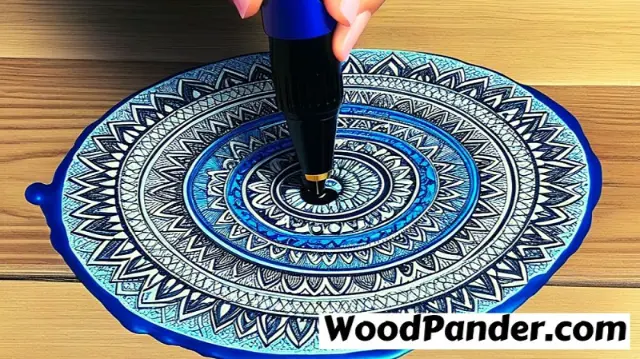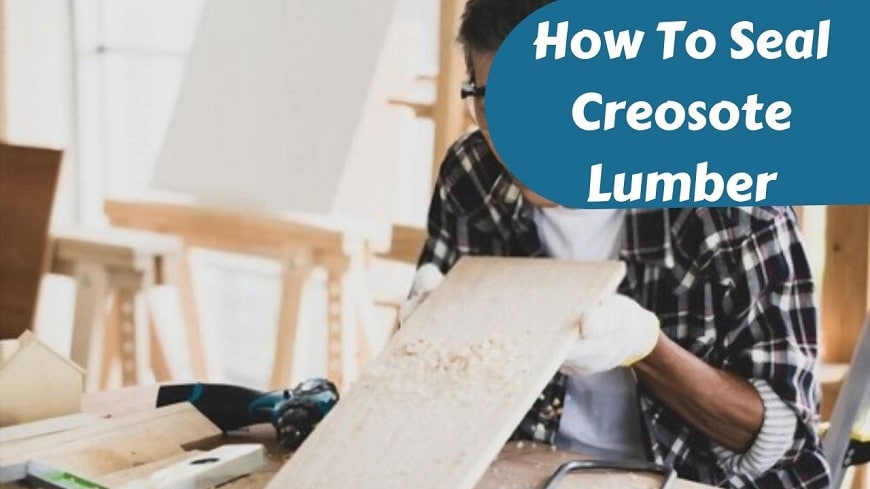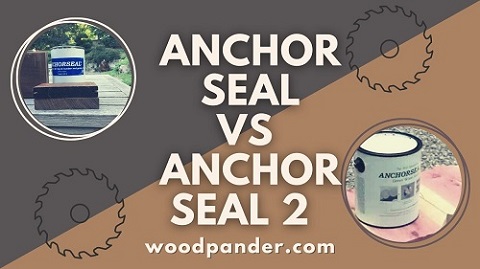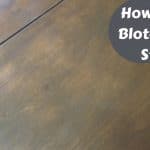Did you try to draw to a wooden surface with your sharpie markers? And you are so amazed at the outcome and want to preserve the art for years. It’s understandable.
So, how to seal sharpie on wood?
Yes, you can seal sharpie on wood following 3 methods. The first one is applying sealant. This is the easiest of all. Then comes the mod podge method. It’s also quite easy to accomplish. Finally, the last technique is varnishing. You can choose any of these methods to seal your wooden artwork.
However, it’s hard to understand the procedure from this amount of information. So, we provided step-by-step guidance to solve this issue.
If you got some time, let’s have a look into the writing-
How To Seal Sharpie On Wood
| Method | Ease of Application | Durability | Appearance | Cost |
|---|---|---|---|---|
| Polyurethane Varnish | Easy | Very durable | Glossy finish | $$ |
| Clear Epoxy Resin | Moderate | Highly durable | Clear, glossy finish | $$$ |
| Acrylic Sealant | Easy | Moderate durability | Satin finish | $ |
| Shellac | Moderate | Moderate durability | Amber tone | $$ |
| Mod Podge | Easy | Low durability | Matte finish | $ |
| Clear Lacquer Spray | Easy | Moderate durability | Glossy finish | $ |
One of our articles –How To Make Wood Engraving Stand Out.
Artworks done by markers are getting popular day by day. As Sharpie markers work well, people are using them on wood too. But after the paintwork, they need to seal the sharpie to protect the art for years.
Now, there are various ways to seal your sharpie markers on wood. But few of them work really well and are popular amongst the artists.
So, we will show you the three most popular methods. From these options, you can choose one, which will work best for you-
Method 1 of 3: Applying Decent Sealant
Most of the artists use a decent sealant to overcoat their artwork. It protects the ink to last for years without being bled. Though it depends on the product’s quality. The quality depends on how long it can hold the ink and serve the purpose.
Keep in mind to read the instructions before buying sealant. As different sealants serve different delivery methods. If you choose the wrong sealant it may affect the artwork.
Another thing you need to decide is if the artwork will remain indoor or outdoor. Because the sealing process will vary for both places.
So, here, we will share the processes for both indoor and outdoor wooden art-
Sealing Indoor Artwork
First, wait about 24 hours so your sharpie marker is fully absorbed into the wood. Now, hold the sealant spray at least 30cm away from the wooden artwork. Then spray an even coat over the wood.
This is where you might apply an uneven coat. Or you might leave some area out completely. As a result, the final outcome will disappoint you. You have to avoid these types of mistakes. Try to coat equally and evenly on each side of your wood.
When the coating is done, leave it to dry for 24 hours. You must wait for the sealant to dry before showcasing the artwork in an open area.
Note: There are some sealants that require two coatings to offer optimal protection though. So, always go through the label to acknowledge the specific requirements. Then buy the sealant that suits your painting surface the best.
Sealing Outdoor Artwork
Ink’s longevity is gonna be your first concern if the artwork is placed outside. Because most of the sharpie markers will fade their color and details over time.
To prevent the ink from fading away you need a sealant that offers UV protection. It will preserve the ink from UV light and will keep the artwork protected.
But wait, let us tell you something, some of these sealants offer less protection. Their performance loses against wind and rain. So, people use multiple sealants to hold the artwork perfectly. And it is truly beneficial for the artworks to stay unharmed for years.
Anyway, let’s check out the procedure now-
So, firstly let your artwork dry properly. Then spray UV protective sealant all over your art. Once done, wait 24 hours.
Next, apply the heavy-duty sealant over the UV protective sealant. It will work as the outer coat and will ensure the best possible protection.
That’s all! Your sharpie artwork is totally protected now, thanks to the sealant!
Method 2 of 3: Applying Mod Podge for Both Indoor & Outdoor
Using mod podge is another way to seal the sharpie wooden artwork. But there is a certain type of mod podge you have to use. So, make sure to buy the mod podge with a white tub, yellow label, and red text.
As you know, you have to let the artwork dry first. Then you can start the coating process. Firstly, apply a very thin layer over the sharpie. Because a thin layer will seal the sharpie correctly as well as maintain good visibility.
But people often make one mistake. They overcoat the sharpie by applying too much mod podge. This affects the artwork’s quality.
You can even overcoat your artwork twice. For that, wait until the first coating is totally dried. Then being extremely careful, apply the second coat. Now, let it dry once again.
If it looks complicated for you, apply a sealant to seal your sharpie artwork.
Method 3 of 3: Varnishing Over Sharpie
The last method you can try is varnishing on sharpie over wooden arts. People have different experiences with this process. Because they got mixed results as there are different variables involved throughout the procedure.
But if you practice a few times, varnishing can work really well. You can test over woods to practice varnish spraying. Then you’ll get the idea of what your combination is gonna look like.
Remember one thing, sharpie markers are alcohol-based markers. And varnishing sprays might also contain alcohol. When you put two alcohol-based products together they might harm your artwork.
So, buy a varnishing spray that has no alcohol in it. Then spray it over your sharpie art.
Well, the color of your sharpie markers will also affect the varnishing. Black sharpies perform better with vanish-based artwork. Whereas, lighter varnishes can also work with colorful sharpies. But the outcome won’t be as pleasing as the dark ones.
Note: Some people might make this overly complicated. The reasons behind the complexity are using the wrong products or using the right product incorrectly. These mistakes make the whole process nothing but a mess.
Method 4: Clear Sealant Spray
Clear sealant spray is an effective method for sealing Sharpie on wood. It provides a protective layer that helps to prevent smudging and fading of the marker ink.
To apply the clear sealant spray, start by cleaning the wood surface and ensuring it is dry. Then, hold the can about 6-8 inches away from the wood and spray an even coat over the Sharpie markings. Allow the sealant to dry completely before handling the wood.
The benefits of using clear sealant spray include its ease of application and quick drying time.
However, it’s important to consider that some sealant sprays may alter the color or finish of the wood, so it’s recommended to test it on a small, inconspicuous area first.
Method 5: Shellac
Shellac is another effective method for sealing Sharpie on wood. It provides a durable and protective finish that helps to preserve the marker ink.
To apply shellac, you will need a brush or a cloth pad. Start by cleaning the wood surface and ensuring it is dry. Then, apply a thin and even coat of shellac over the Sharpie markings. Allow it to dry completely before handling the wood.
The advantages of using shellac include its quick drying time and the ability to enhance the wood’s natural beauty. However, it may not be as resistant to water or heat as other sealants.
Method 6: Polyurethane
Polyurethane is a popular choice for sealing Sharpie on wood due to its durability and protective properties. It forms a strong barrier that helps to prevent the Sharpie ink from smudging or fading over time.
To apply polyurethane, start by preparing the wood surface. Ensure it is clean and free from any dust or debris. Then, using a brush or a foam applicator, apply a thin and even coat of polyurethane over the Sharpie markings. Make sure to follow the wood grain for a smooth finish.
Allow the polyurethane to dry completely before handling the wood. The drying time can vary depending on the brand and type of polyurethane used, so it’s important to read the manufacturer’s instructions. Generally, it takes around 24 hours for the polyurethane to fully cure.
One of the advantages of using polyurethane is its strong resistance to water and heat. This makes it suitable for both indoor and outdoor applications. Additionally, polyurethane can enhance the natural beauty of the wood, giving it a glossy or satin finish.
However, there are a few considerations to keep in mind when using polyurethane. It can sometimes yellow over time, especially when exposed to sunlight. Additionally, applying multiple coats may be necessary for optimal protection.
Method 7: Lacquer
Lacquer is another effective option for sealing Sharpie on wood. It is a clear, protective finish that provides a glossy and durable coating. Lacquer is known for its quick-drying properties, making it a convenient choice for sealing Sharpie designs on wood.
To apply lacquer on Sharpie designs, start by ensuring that the wood surface is clean and free from any dust or debris. Shake the lacquer can well to mix the contents thoroughly. Hold the can about 8-12 inches away from the wood surface and spray a light, even coat of lacquer over the Sharpie markings.
Allow the lacquer to dry completely between coats, following the manufacturer’s instructions. Depending on the brand and type of lacquer, this can take anywhere from a few minutes to a couple of hours. Apply multiple thin coats for optimal protection and a smooth finish.
Lacquer offers several advantages as a sealing option for Sharpie on wood. It provides a high-gloss finish that enhances the vibrancy of the Sharpie colors.
Lacquer also forms a protective barrier that helps to prevent smudging and fading over time. Additionally, lacquer is resistant to water and heat, making it suitable for both indoor and outdoor applications.
However, there are a few cautions to keep in mind when using lacquer. It can sometimes react with certain types of Sharpie ink, causing the colors to bleed or fade.
To avoid this, it’s recommended to test the lacquer on a small, inconspicuous area before applying it to the entire design. Additionally, lacquer can be toxic and should be used in a well-ventilated area.
Method 8: Epoxy Resin
Epoxy resin is a popular choice for sealing Sharpie on wood due to its strong protective properties. It forms a durable, clear coating that enhances the longevity of the Sharpie design.
Epoxy resin is resistant to water, heat, and UV rays, making it suitable for both indoor and outdoor applications. It also provides a glossy finish that adds depth and vibrancy to the colors.
To apply epoxy resin on Sharpie designs, start by preparing the wood surface. Ensure it is clean, dry, and free from any dust or debris. Mix the epoxy resin according to the manufacturer’s instructions, making sure to follow the correct ratio of resin and hardener.
Next, pour the mixed epoxy resin onto the wood surface, spreading it evenly with a foam brush or a spreader tool. Use a heat gun or a torch to remove any air bubbles that may have formed. Allow the resin to cure completely, which can take anywhere from 24 to 72 hours, depending on the brand and type of epoxy resin.
Using epoxy resin to seal Sharpie on wood offers several benefits. It provides a strong protective barrier against smudging, fading, and moisture damage.
The glossy finish enhances the appearance of the Sharpie design, making it more vibrant and eye-catching. Epoxy resin is also easy to clean and maintain, ensuring the longevity of the sealed artwork.
However, there are a few considerations to keep in mind when using epoxy resin. It can be a more time-consuming process compared to other sealing methods due to the curing time.
Additionally, epoxy resin can be toxic, so it’s important to work in a well-ventilated area and follow safety precautions.
Method 9: Wax
To seal Sharpie on wood using wax, start by applying a thin layer of wax onto the surface using a soft cloth or brush. Make sure to cover the entire design. Allow the wax to dry for a few minutes, then use a clean cloth to buff the surface in circular motions.
This will help to remove any excess wax and create a smooth, polished finish. Remember to reapply wax periodically to maintain the seal and protect the Sharpie design.
Method 10: Heat Setting
To seal Sharpie on wood, another method you can try is heat setting. Heat setting involves using heat to help the Sharpie ink bond with the wood surface.
This method is effective in preventing smudging and fading of the design. To heat set a Sharpie design on wood, use a heat gun or a hairdryer on a low heat setting.
Keep the heat source moving to avoid scorching the wood.
Remember to take safety precautions and work in a well-ventilated area. Heat setting can provide a durable seal for your Sharpie design on wood.
How to Write on Wood
To write on wood, you can use a Sharpie marker. Start by preparing the wood surface, ensuring it is clean and smooth.
Then, choose the desired Sharpie color and begin writing or drawing on the wood.
Take your time and be careful to avoid smudging. Once you are done, let the Sharpie ink dry completely before sealing it to protect the design.
Can You Varnish Over Sharpie On Wood?
When it comes to preserving and protecting your Sharpie designs on wood, varnishing can be a great option.
Varnish creates a clear protective layer that helps to seal in the Sharpie ink and prevent it from smudging or fading over time. Before applying varnish, ensure the Sharpie ink is completely dry.
Choose a clear varnish suitable for wood surfaces and apply thin, even coats. Varnishing not only protects the design but also enhances its longevity and provides a glossy finish.
Can You Mod Podge Over Sharpie On Wood?
Mod Podge is a popular crafting adhesive that can be used for various projects, including decoupage and sealing. But can you use Mod Podge over Sharpie on wood? The answer is yes, you can.
Mod Podge can be applied over Sharpie on wood to seal and protect the design. It creates a clear, protective layer that helps to prevent the Sharpie ink from smudging or fading over time. Before applying Mod Podge, make sure the Sharpie ink is completely dry. This will ensure that the colors do not bleed or mix with the Mod Podge.
To apply Mod Podge over Sharpie on wood, start by brushing a thin, even layer of Mod Podge over the design. Make sure to cover the entire surface to ensure proper protection. Allow the Mod Podge to dry completely before applying additional coats. Depending on the desired level of protection, you can apply multiple coats of Mod Podge.
Mod Podge is available in different finishes, such as matte, gloss, and satin. Choose the finish that best complements your design and desired look. The Mod Podge will not only seal and protect the Sharpie design but also give it a smooth, finished appearance.
One of our articles –How To Remove Polycrylic Finish.

Important Tips on How to Prevent Sharpie Bleeding on Wood
While sealing many artists face this problem. Their sharpie marker bleeds and the whole art gets destroyed. But there’s always a way.
You can prevent sharpie’s bleeding by applying white glue. This works like magic. To apply it, just follow these tips of ours-
- Firstly, take some glue in a bowl and mix water with it. Make a thin liquid so the texture doesn’t affect the artwork. The ideal proportion is 2:1, try to maintain that.
- Then coat the wood with this glue with the help of a brush. You have to coat a thin layer over the sharpie artwork. Try to brush correctly so no tiny bubble shows up. Now, coat each side of the wood properly.
- When the coating is done, let it dry completely. At least wait for half an hour to 1 hour. But if you’re in a hurry use a hairdryer to speed up the process. Blow for 4-5 minutes to let the glue dry.
- When you are sure enough that the glue has dried perfectly, then start painting.
Hopefully, this technique will prevent the marker from getting bled.
Related Questions
How do you preserve sharpie on wood?
You can preserve your sharpie on wood through mod podge. But there are different types of mod podges in the market. You have to pick the one with a white tub, yellow label, and red text. Its texture is gonna preserve the sharpie pretty well.
Can you clear the coat over the permanent marker?
Before coating over the marker, set the marker to dry properly. At least for a day. Then you can use a Krylon spray to seal your paint. You should spray in a light layer without applying pressure. Or you can spray a heavy liquid over your permanent marker.
How do you seal sharpie on painted wood?
Firstly, wait until the sharpie is perfectly dry. Then overcoat your paint through a water-based spray. You can try waterborne finishes as well. So, any of those can hold the paint on wood for years.
What can I seal sharpie with?
You can seal your sharpie by using a mod podge. It is a glue that can also be a sealer. It is often used to overcoat decoupage art. You can have either a matte finishing or a gloss finishing. Any of those works well with sharpie markers.
How do you protect Sharpie signature on wood?
To protect a Sharpie signature on wood, apply a clear sealant or varnish over the signature to prevent smudging or fading.
How do you seal Sharpie?
To seal Sharpie ink, apply a clear acrylic spray or varnish over the design to protect it from smudging or fading.
What is the best clear coat for Sharpie?
The best clear coat for Sharpie markers is typically a spray acrylic sealer, such as Krylon's Clear Acrylic Spray or Rust-Oleum's Clear Gloss Spray, as they provide a durable and protective finish without smudging the ink.
How do you get Sharpie off wood without ruining the finish?
To remove Sharpie marks from wood without damaging the finish, gently rub the affected area with isopropyl alcohol using a soft cloth until the ink lifts off.
Final Words
We hope you got the solution for how to seal sharpie on wood.
In brief, we tried to explain 3 easy methods to you. It might look a little complex to you. But believe us, these sealing processes are really simple.
You can share your sealing experience with us by leaving a comment down below.
Wish you all the luck!
Sources:




![How To Thin Shellac? [In 10 Easy Steps] how to thin shellac](https://woodpander.com/wp-content/uploads/2021/08/how-to-thin-shellac.jpg)



